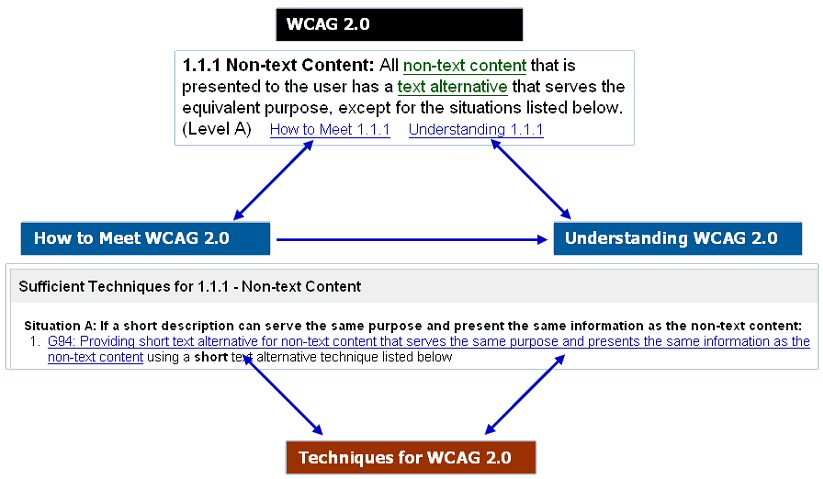WAI: Strategies, guidelines, resources to make the Web accessible to people with disabilities
Site Navigation: W3C Home > WAI Home > WCAG Overview
This page describes the different WCAG 2.0 technical documents, to help you know where to go for which type of information. For background, an introduction to WCAG, and links to additional information, see Web Content Accessibility Guidelines (WCAG) Overview.

Figure 1: WCAG 2.0 documents
Web Content Accessibility Guidelines (WCAG) 2.0 itself is designed to be a stable, referenceable technical standard. Most people will use the supporting documents when developing Web content and Web tools, instead of the actual technical standards document.

How to Meet WCAG 2.0: A customizable quick reference to WCAG 2.0 requirements (Success Criteria) and techniques is a key resource for designers and developers using WCAG 2.0. It includes all the WCAG 2.0 guidelines and success criteria. It is essentially the WCAG 2.0 checklist.
The success criteria are the testable statements that define how Web content meets (conforms to) WCAG 2.0. Under each success criteria are a list of sufficient techniques; that is, if you implement those techniques you meet the success criteria. It also lists common failures, that is, things that do not meet the guidelines.
You can customize How to Meet WCAG 2.0 based on whether you are using CSS, JavaScript, multimedia, or other Web technologies. You can also select to show Level A, AA, or AAA success criteria.
Understanding WCAG 2.0: A guide to understanding and implementing Web Content Accessibility Guidelines 2.0 has additional details for people who want to understand the guidelines and success criteria more thoroughly. It provide extensive guidance, including the intent of the guideline or success criterion; how it helps people with different disabilities, browser and assistive technology support notes, examples, and resources, such as tools to check color contrast.
Techniques for WCAG 2.0: Techniques and Failures for Web Content Accessibility Guidelines 2.0 gives specific guidance for developers on how to develop accessible Web content. It provides general and technology-specific examples, including for HTML/XHTML, CSS, scripting, multimedia, and WAI-ARIA. There are also common failures that show what to avoid.
The WCAG 2.0 documents are interlinked. For example:

See the navigation area of the WCAG Overview for other materials related to WCAG 2.0, such as WCAG 2 FAQ, WCAG 2.0 at a Glance, How to Update Your Web Site from WCAG 1.0 to WCAG 2.0, and WCAG 2.0 presentations.